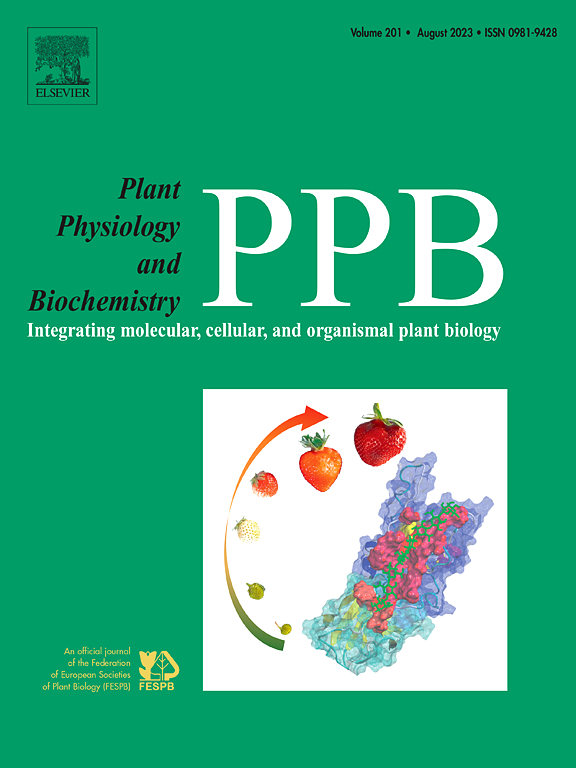薏苡米(Coix lacryma-jobi L.) wr1 (wrinkle 1)基因家族调控非生物应激反应的全基因组特征
IF 5.7
2区 生物学
Q1 PLANT SCIENCES
引用次数: 0
摘要
薏苡仁(Coix lacryma-jobi L.)因其营养价值和药用价值而被称为“禾科之王”,是一种具有食用和治疗双重用途的作物。wr1 (wrinkle 1)是AP2家族转录因子,在植物发育和逆境适应中起着关键作用。尽管wr1基因已经在一些物种中被研究过,但其在薏苡米中的功能在很大程度上仍不明确。在这里,我们确定了分布在10条染色体上的20个ClWRI1基因,并根据系统发育关系、保守基序和基因结构将它们分为三个亚家族。表达谱显示ClWRI1基因广泛表达,在种子中表达水平显著。转录组学和qRT-PCR分析显示,一些ClWRI1基因对干旱、盐度、寒冷和热胁迫有反应,表明它们参与了非生物胁迫反应。ClWRI1-18和ClWRI1-20在酵母中的异源表达增强了胁迫耐受性,支持了它们的功能相关性。酵母双杂交实验进一步证实了ClWRI1-18和ClWRI1-20之间的物理互作。综上所述,这些发现表明,WRI1基因家族参与了薏薏的应激适应,其中ClWRI1-18和ClWRI1-20是遗传改良的关键候选基因。本文章由计算机程序翻译,如有差异,请以英文原文为准。
Genome-wide characterization of WRI1(WRINKLED1) gene family as a regulators of abiotic stress response in Coix (Coix lacryma-jobi L.)
Coix (Coix lacryma-jobi L.), known as the “King of the Gramineae” for its nutritional and medicinal value, is a dual-purpose crop with both edible and therapeutic applications. WRI1 (WRINKLED1), an AP2 family transcription factor, plays a pivotal role in plant development and stress adaptation. Although WRI1 genes have been studied in several species, their functions in Coix remain largely uncharacterized. Here, we identified 20 ClWRI1 genes distributed across 10 chromosomes and classified them into three subfamilies based on phylogenetic relationships, conserved motifs, and gene structures. Expression profiling revealed that ClWRI1 genes are widely expressed, with pronounced levels in seeds. Transcriptomic and qRT-PCR analyses showed that several ClWRI1 genes respond to drought, salinity, cold, and heat stress, suggesting their involvement in abiotic stress responses. Heterologous expression of ClWRI1-18 and ClWRI1-20 in yeast conferred enhanced stress tolerance, supporting their functional relevance. Yeast two-hybrid assays further confirmed a physical interaction between ClWRI1-18 and ClWRI1-20. Collectively, these findings indicate that the WRI1 gene family contributes to stress adaptation in Coix, with ClWRI1-18 and ClWRI1-20 representing key candidates for genetic improvement.
求助全文
通过发布文献求助,成功后即可免费获取论文全文。
去求助
来源期刊
CiteScore
11.10
自引率
3.10%
发文量
410
审稿时长
33 days
期刊介绍:
Plant Physiology and Biochemistry publishes original theoretical, experimental and technical contributions in the various fields of plant physiology (biochemistry, physiology, structure, genetics, plant-microbe interactions, etc.) at diverse levels of integration (molecular, subcellular, cellular, organ, whole plant, environmental). Opinions expressed in the journal are the sole responsibility of the authors and publication does not imply the editors'' agreement.
Manuscripts describing molecular-genetic and/or gene expression data that are not integrated with biochemical analysis and/or actual measurements of plant physiological processes are not suitable for PPB. Also "Omics" studies (transcriptomics, proteomics, metabolomics, etc.) reporting descriptive analysis without an element of functional validation assays, will not be considered. Similarly, applied agronomic or phytochemical studies that generate no new, fundamental insights in plant physiological and/or biochemical processes are not suitable for publication in PPB.
Plant Physiology and Biochemistry publishes several types of articles: Reviews, Papers and Short Papers. Articles for Reviews are either invited by the editor or proposed by the authors for the editor''s prior agreement. Reviews should not exceed 40 typewritten pages and Short Papers no more than approximately 8 typewritten pages. The fundamental character of Plant Physiology and Biochemistry remains that of a journal for original results.

 求助内容:
求助内容: 应助结果提醒方式:
应助结果提醒方式:


